Text
Using the four pillars of play in RPG design.
Talking aloud to myself here on how to design an RPG.
As designers, we want to have a game encompass everything. The intrinsic nature to add on more mechanics for more edgecases is inescapable - but it leads to a bloated mess that is unnavigable and unapproachable. The more the game bloats, the more errors wil creep in, and the harder the game will be to play. Not to mention the fact that the game in practice will on average be about 60% by the book and 40% homebrew, and in the moment judgements from the GM.

An example of design without boundaries.
...So what do we do? How do we set boundaries that will help deliver the RPG experience we want to create, without being too restrictive? The answer is quite simple: Consider the audience.
An RPG - or any game (or product) for that matter - should have a targeted audience or user experience. Why would you play this? How does it feel to play? Who wants that experience? And to help define that, I would like to use the "four pillars of RPGs" that I mused on before.

There can actually be a lot of pillars. Like a lot a lot - each game may make their own pillars for specific key elements.
All games have Roleplay, Combat, Exploration, and my handcrafted fourth, "Meta." All RPGs have these pillars in varied amounts, and players focus on them in different amounts as well.
A player who focuses on the pillar of Roleplay will be interested in character creation, sure, but the hook for them will likely be the art and setting of the system, giving their imagination fertile ground to play in in the first place. A player focused on Combat will be more concerned with the mechanics - how one goes about interactions and "winning" the game portions of an RPG. An Exploration focused player will equally be interested in both the setting and the mechanics needed to interact with it - their own character is almost ancillary to the point. A player focused on "Meta" is one who spends more time playing the game away from the table than at it. This is the player who theorycrafts, homebrews, and has thirteen new characters written up by the second session.
So lets give these pillar-players some quick names:
-The Roleplayer, who wants to tell their story.
-The Gamer, who wants to win a challenge.
-The Explorer, who wants to find an experience.
-The Metagamer, who wants a toybox to build with.

The MTG classic Timmy, Johny, and Spike trio can also work - Timmy is an Explorer, Johny is a Roleplayer, Spike the Gamer.
Our roles defined, how do they focus us in on the design front?
Let's start with the Roleplayer. They live for creative expression - they want a unique character with a unique story, living unique experiences. First and foremost, art will likely be their hook. Seeing a book on a shelf and saying "I want to go there!"
...But seeing as art is the packaging rather than specific design, let's start at character creation. For the Roleplayer, this should be robust, replete with options to express a specific character. Giving rules for backgrounds, a full set of skills, unique species complete with lore, etc. One thing I would specifically highlight would be giving a character flaws - either enforced or by choice. Giving a character a hangup is an especially juicy opportunity to have dramatic moments of either overcoming or failing due to a flaw.
Once the Roleplayer's character is created, it's time to play - and once again, the focus is on expression - so having many approaches to a problem is key. Sure, a fight might be a solution to a blockade, but so is stealth - and negotiations, and trickery, and going a different route, and and and... You get the point. Making a tool for every scenario is hard to do - and it puts a lot of pressure on the Game Master (if you have one) to be able to think on their feet - so when it comes to designing, a lot of the work comes down on the rules behind the GM's screen. Broad, flexible categories and tables that can be easily adapted to any situation the Roleplayer may suddenly think up. When they say "I want to drop a barrel on their head!" the GM needs the resources necessary to say "ah, yes, so that would be a difficult task with an improvised object, and will leave them restrained. Here's your roll."
Roleplaying in and of itsself is an important part of the Roleplayer's repetoire, but it is not the only thing. When designing for Roleplayers a robust system of speechcraft and influence is good, but is still secondary to having a system that is flexible over all situations.

A Roleplayer may or may not be a Bard. They would totally woo the dragon though.
Designing for the Gamer is simple enough. They play to 'win.' This is the person that skips over character creation to look at combat, then goes back to craft a barbarian specialized in in javelins because it's "optimal." They will put the actual moment-to-moment rules of a game to the test. Flexibility is less important than optimization, and they absolutely will call you out if something isn't balanced correctly. This is the player who wants spreadsheets, statlines, and the functional mechanics first and foremost. A description of Goblin society is far less important that their to-hit numbers and special moves.
And a Gamer is not limited to combat - they will want to win anything that has proper rules - as likely to create a master stone mason as a master swordsman, so long as there is a system of rules there - a "puzzle" to "solve." So designing for Gamers is a mater of making those puzzles - clear, up-front rules that work together well to present challenges directly to the players. While the Roleplayer requires GM-facing tables to handle creative solutions, the Gamer requires player-facing tables to figure out the logical solutions themselves.

"The Senator class gives me +2 against people with a different political alignment. Your move."
The Explorer isn't so singularly focused. The explorer isn't here to express themsleves or state their mastery, but are here to find things out. They love the "aha!" moments and shiny trinkets found at the bottom of deep wells. And as such, they may well take the most effort to cater to.
It may be counterintuitive, but the Explorer likes to not know things. While a Gamer prefers all the cards out on the table, the Explorer would rather figure them out by trial-and-error. So rules that can hide information from the players are important. Rather than revaling a map, have rules for map-making. Rules for identifying magic items. Monster descriptions to present, instead of a stat block to reveal. Doing all of this essentially doubles the writing, as you need both the functional and the descriptive angles of all things.
Rules that further complicate discovering things will also be intriguing to the explorer - an expendable torch mechanic when going underground, weather mechanics that complicate overland travel, exposure mechanics for hazardous areas and materials - overcoming these obstacles to plumb even greater depths is the ideal gameplay loop for the Explorer.
And that's before considering all the cool trinkets and baubles that a player will unearth during their explorations - a full catalogue of unique places and items should be held in reserve to ensure that there's always more to explore, and to explore for.
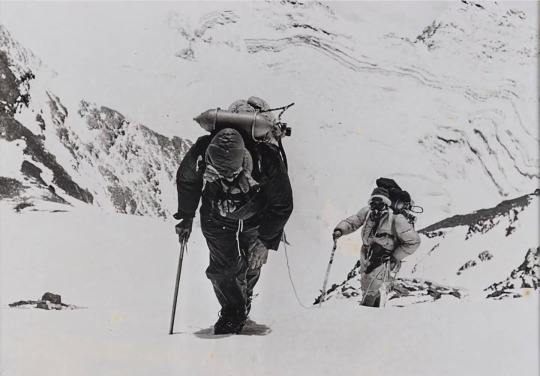
Why? Because it's there, of course. Why not?
And finally we get to the Metagamer. The gamer that plays away from the table as much as at it. The player who has a mounting pile of backup characters every single session. The player who loves to ask themselves "what if?"
This player loves all the rules, all the charts, and all the fluff. They resemble all three of the other players at points, but their focus is elsewhere. For them, the rules are a toybox full of interesting things to mash together. Character creation is less self-expression, more an experimental labrotory. Combat isn't a puzzle to solve, but a showcase to put the biggest, coolest thing in. A list of items isn't something to be discovered, but a catalogue of things to order.
The Metagamer cares less for the specific moment-to-moment gameplay or optimal solutions, but more for the thrill of making what could be the biggest or fastest or coolest things that could possibly be. So designing for enthusiastic Metagamers is less a choice of what systems are necessary, and more a practice at making sure that all systems are linked. Exploration can give things that are useful in Roleplay, and Roleplay effects Combat, and so on. A Metagamer will gleefully run away with the idea of fall damage being added to an attack, even if no fights ever happen at the bottom of cliff faces - merely because a 300-foot piledriver sounds awesome.

My next character is a cybernetic luchador bear that can deliver a flying lariat at mach two.
I would be remiss not to mention the Game Master as well - as the teacher, and most likely the purchaser of the RPG, they are the first player you must woo over to your system. But other than making sure the game is understandable and laid out in a way that is easy to reference, there's not really any focus to give to specific components - a GM may tend towards the "Gamer" or "Metagamer," but they are as likely to have traits from any of the player pillars. So to make that initial sale, the focus should be on clarity - "THIS GAME IS MADE FOR THIS PURPOSE." Once a GM knows what the game is about, they can then ask if it fits their style.

The magic that goes on behind these three panels...
Now, most players are a mix of these traits. Rarely does a Gamer not have an element of the Metagamer. Explorers can be as much a Roleplayer as a Gamer, and in certain scenarios players may be all four at once. But by choosing a pillar to focus on, or at least prioritise, we start to set our limits.
If a rule or system does not serve to cater towards our focus, and is not necessary for the game to function, it should not be given priority. Does a game for Roleplayers need a detailed list of poisons when a simple "poisoned" effect will convey the emergency? Does a system for Gamers need four pages of background lore? Do you really need that system for playing the stock market?
There is no perfect guideline for me to present here. But it is still good, every once in awhile, to hold your system at arm's length and say, "Who, really, is this game for? And does what I'm doing accomplish that?"
At the very least, it's helped me trim the fat a few times.
Happy creating, designers.
5 notes
·
View notes
Text
The Resolution Gradient
Every time I am presented with a new RPG - or really any game - the first thing I look for is new mechanics. Some element of interest to engage my tiny little designer brain and allow me to fool myself into thinking it isn't a feckless expenditure, because it's new and different.
For RPGs, the simplest thing to look at is "what is the resolution mechanic?" If I want to do thing A in the game world what is the thing B I must do in meatspace to achieve it? There's a lot of different answers to that question these days - from roll over a threshold, to dice pools, to cards, block towers, metacurrencies, and 'I said it, therefore it is.' But what I want to look at right this moment is what comes afterwards - I did the thing, so what's the result?

The most basic option is the simple pass/fail. "Yes" and "no." You roll a die, draw a card, whatever - you get enough, and you get to do the action you rolled for. If you don't, you don't. Extremely easy to understand, and perfectly functional. ...but it does get a bit boring after a while...

Introducing the new and exciting way to resolve situations: The critical hit! Get the bestest number, get a better result! We all know what this is, and we all love it. Critical hit, nat 20, whatever you call it, it's so beloved that if it doesn't exist, it is the first thing naturally homebrewed into a game. The critical hit mechanically functions as a "yes, and" result. Roll a 20 in DnD? "Yes, you hit, and you do double damage."
It can be made more granular as well - roll 4 or more over the threshold in Savage Worlds? "Yes, and you get a raise." Roll eight above and you get two raises - depending on the system, there may actually be no limit to how big the "and" in "yes, and" can be. In a system such as this, character growth continues to be relevant for much longer. Sure, your character may be guaranteed to succeed in a given task, but if you add on to that stat just a bit more you can succeed so hard that you get bonus rewards!

...But what if we don't want guaranteed success? Then we come to the dark reflection: "no, and." The crit fail. You roll a one, or pull a result so bad that simple failure isn't enough. You drop your sword, slip on the ice, and make rude gestures at your grandma, all at once. This result isn't as popular as the critical hit, (unless the game master is rolling it,) but does serve a vital function in never letting players be too comfortable. Ideally, a game should always present players with an appropriate challenge - but the critical miss is still available as a saafety net if things get too out of hand. And depending on the game, the "no, and" may be more than slapstick - stick it in an opressive environment where you'll fail more often than not, and suddenly players are rolling not to succeed, but simply to not lose too much in the failure.

If that tone seems a bit much though, there is the option of 'failing forward.' Throwing the players a bone for a near-miss with a "no, but." For some, this is the default failure state - the action didn't succeed as planned, but something still happened. Maybe you got part of a task done, or something new that may help future checks, or just a hint towards something else to try instead. This has become quite popular both in making rules and game mastering as it maintains momentum during a game - you never hit a wall because a lock won't open, but slip into a sidequest with a hint of where to find a key.
If handled poorly, this can seem like a 'no-loss' mechanic - if every roll is movement towards the goal, regardless of the result, where are the stakes? It's contingent on game masters, scenario writers, and even game designers to build in enough options for the "no, but" mechanic to keep it feeling interesting and relevant.

"No, but" does have its own shadowy twin in the "yes, but" result. This result can maintain the low-roll threat of a critical failure without needing to stoop to absurd bad luck. If you succeed, but not by a large margin, maybe the trader begrudgingly agrees with your plan - but counts it as a favor spent. Maybe you break a pick opening a lock, or maybe you're playing Blades in the Dark and you successfully escape the warehouse - but you added to the doom clock in the process, and now guards are prowling the streets. "Yes, but" is a good way of keeping the pressure on, even when things are ostensibly going well, a bit of a nudge to make sure that the players are prepared, and able to keep moving at the pace they're at.

...there technically is one more tone to this gradient: The neutral result. You roll to leap into a moving helicopter from a burning building and... Nothing. You didn't land in the helicopter, you didn't fall to your doom, the game just shrugs its shoulders and says 'meh.' You may be able to try arain, but for now, nothing happens. I don't know of any games that do this, and for good reason - it doesn't move the story forward at all, provides no risk, and no reward. Don't do this without good reason.
So all in all, removing the "meh" result, the gradient looks like this:

"no, and" "no" "no, but" "yes, but" "yes" "yes, and"
Now for the real question: Which of these grades do you absolutely need in your game? And the absolute, scientific, 100% right answer to that question is...it depends. I would say at least two.
You want at least two, simply because the unexpected and adversity is what makes stories interesting. "You didn't spend the resourece, or you rolled poorly, and now things are going in a way you didn't expect, what do you do now?" But the tone of the story will change what parts of the gradient you use.
You could keep it simple with "yes" and "no" and focus on other things. Perhaps you want to make a particularly miserable world, where players are wading through rotten sloughs and their personal demons - "No, and" "no" and "yes, but." Even the sought-after but rarely found success will have a consequence. Maybe you're looking for an explosive adventure of superhumans who heroically succeed or fail in bombastic fashion - "Yes, and" "yes, but" "no, and." Maybe you really love granularity and want to write a million different results for every eventuality - just use all six!
There's really no limit here, and there may also be additional granularity you can unpack between and around these categories. But all in all, I'd just recommend: Next time you're about to tell a player "no," consider saying, "no, but..."
...Or, if it's that one guy, throw down a "no, and."
Either way, keep it interesting at the table.
4 notes
·
View notes
Text
Cazadores 1.6 available for preview!
New rulebook updated for GenCon this week! Go check it out on the Luft website!
Downloads — Luft Games (luftoffline.com)
0 notes
Text

Want to take a breif moment to consider something we've all seen before, in designing and even just playing RPGs: The Three Pillars.
We've all heard of them before - "gameplay can be split into three pillars; Combat, Exploration, and Roleplay." Combat is where you beat up whoever is getting in the way, Roleplay is when there's noone to beat up, and Exploration is getting from one Combat or Roleplay encounter to the next. Sometimes the edges of these blend a bit, but this is the general understanding of the pillars.
We use these pillars and how prominent they are to judge wether or not a game is for us, or even a good game in the first place. If the Combat's too simplified, why bother getting in fights - if the Roleplay's weak, wouldn't it be better as a boardgame - if the Exploration's not well explained, how do we decide what we're doing? If your three-legged stool is missing a leg, not only is it actually a ladder, but it can't stand up on its own either.
But while these are important things to consider, I believe we've been ignoring a potential fourth leg to the stool: The Metagame. Roleplay, Combat, and Exploration are all events that happen within the game world itsself, but Meta is what goes on outside of the game world. The game itsself, and how you interact with it.
If I may make an over-long example, take baseball.

Considered by many to be a boring game, on the surface, Baseball is simple. Hit the ball, run, score. Do this more than the opponent and win. Let's apply the three pillars, and say the pitch is our Roleplay, hitting is our point of Combat, and then running the bases makes up our Exploration - just like that, we've made a functional game.
...but there's a lot more field out there than just the batter's box and pitcher's mound. And out in that field is where the game comes to life - with the Meta.
In Baseball, a pitch is not just throwing a ball at a target - it's a mind game. What's the pitcher's ability? What kinds of throw can they manage? Who's the hitter? Do they hit better with high balls or low? Where do they hit to on average? Are there people on base? Will that change the tactics, with a bunt or a sacrifice play? And once the ball is in the air, a whole new load of considerations are in play - how fast are the runners? Is is better to make a long throw to stop a point, or make a shorter one for an easy out? And on the recieving end, is the person ready and able to catch the throw, and what will they do with it?
People who enjoy baseball don't just watch it - they study it. They keep statistics in real-time. They know averages by heart. They study lineups, and follow seasonal drafts like paparazzi. All this because baseball has a very rich Meta surrounding the simple premise of 'hit ball, run fast.'

So going back into RPGs, Meta is everything around the specific actions of the Three Pillars. It's the brain-tickling "crunch" that many players tout in their favorite games. It's player expression, not through talking or beating up baddies, but through studying and beating the game itsself.
So, to build the Meta pillar of a game, there needs to be rules that satisfy that creative and puzzle-solving side of the players - often, character creation being the first and foremost example.
Imperium Maledictum (just one table of which is above,) has a number of levels to character creation - home planet, faction, traits, and Role all affecting the character you play with - but it also has another layer - all of these things can be randomized... For XP. The interplay between choice of stats and an initial stat boost make for an interesting system to play with.
Savage Worlds has a system of traits - you start the game with a number of trait points, and can pick character benefits with them. But there's a wrinkle: You can choose negetive traits to give yourself additional trait points. This allows the choice to be selectively weak in order to be stronger at something else, right from the start - and works wonders for Roleplay as the game goes on.
I would dare to say one of the largest games in the industry owes its entire existence to the pillar of Meta. Pathfinder is, are its core, a riff on Dungeons and Dragons. It holds the same focus on combat, Roleplay encounters are largely handled by skills, and hex-crawl Exploration is nothing new. But where it stands out is options. The very races you play as are diverse, and replete with options. Classes can be built a multitude of ways, and even the combat system allows more actions, creating a vast web of potential that players can delve into for ages before even rolling a single die.
And the enjoyment of Meta doesn't end with character creation - having tools and tables for exploration, item generation, and world building are all great tools to engage players and occupy GMs for months at a time.

In direct contrast stands Powered by the Apocalypse: A simple, stripped-down version of the RPG, that features pre-set characters, with pre-set moves. Construction is minimal, and details are vague - Gamma World has charts for weapon damage, classification, and how much fatigue sets in from using it. Apocalypse World simply asks how much harm is dealt when you "exchange harm."
While this is clearly enjoyed by a great many due to the flood of PBtA titles in the past decade, this simplicity is also a horrifying anathema those who love the crunch of old-school RPGs. One is not superior to another, but just as with the classic pillars, a focus (or lack thereof) on Meta changes the balance of a game, and who the intended audience will be.
So, at length; Consider the Meta when building a game. What systems exist that will allow for the game to be enjoyed, even when not at the table? How can the mechanics themselves be used as a tool of self-expression and engagement? Are the rules themselves simply what defines the gameplay, or are they to be played with?
And most importantly, as with any game design, consider: Who is the game for? If your answer is to engage the hyper-fixated nerds among us, then perhaps Meta should be the strongest leg of the four-legged stool.
Anyways, it's a thought.
3 notes
·
View notes
Text
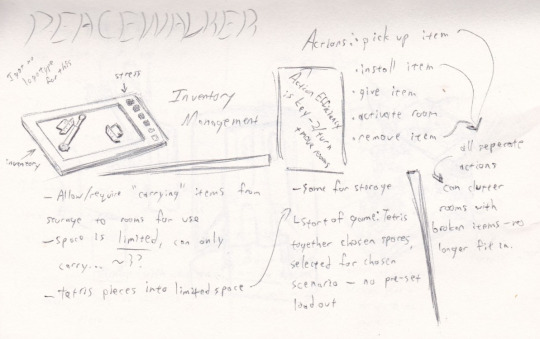
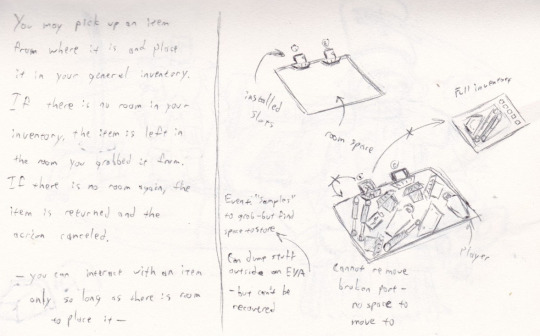

I need to finish up with Cazadores - not just because I don't want to let down those who have been with me through the whole design journey, but also because I have many other games I want to hit the testing circuit as soon as it's out of the way!
Here's a sneak-peek of what's likely next up: A cooperative game, using multi-layered player boards to create inventory limit problems.
Oh, and there may also be chances of lava floes and meteor strikes., but more on that some other time.
0 notes
Text
A brief(ish) history of Cazadores
It has been a long road for Cazadores. Originally just a list of cool dragons from an eight-year-old, it's now being aimed at a future Kickstarter. So why not look at the past, to try and build some of that momentum towards the future?
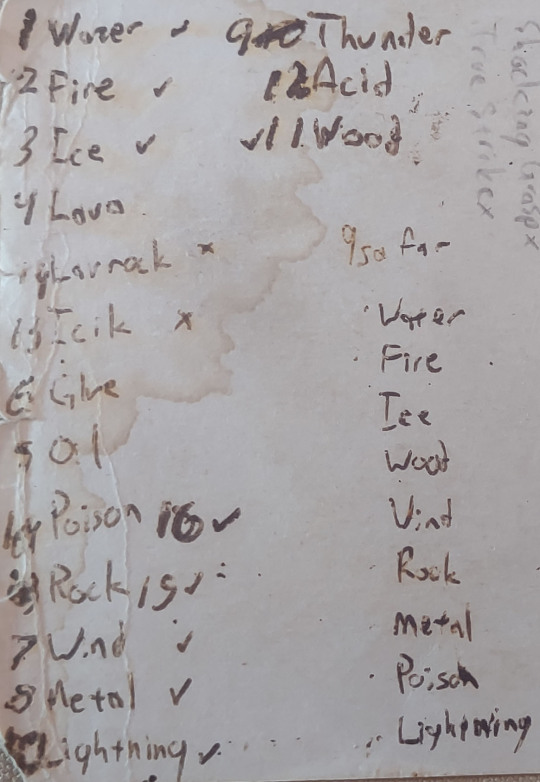
When I said it started as a note on cool types of dragons, I wasn't kidding. And on this grungy old index card is a list of elements for dragons - with such wonderfully bizzare names as "Lavrock" and "Icik." (Like Ice, but different.)
When a child asks if you design games, there's no reason not to listen - not only does it make them happy, but creativity peaks young - so it's a great way to get original ideas. While Icik hasn't made it into Cazadores, some basics of the game were actually hashed out at this time - the goal of the game was to fight a wide swath of monsters, and there would be a market where you would get elemental gear to help you do so.
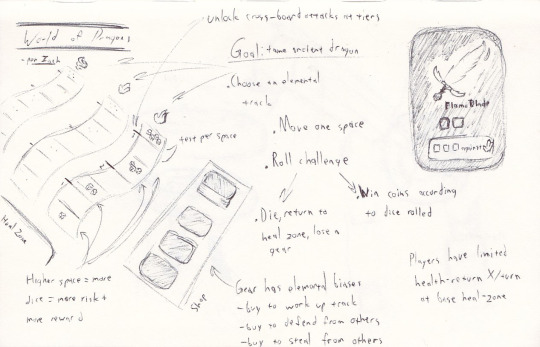
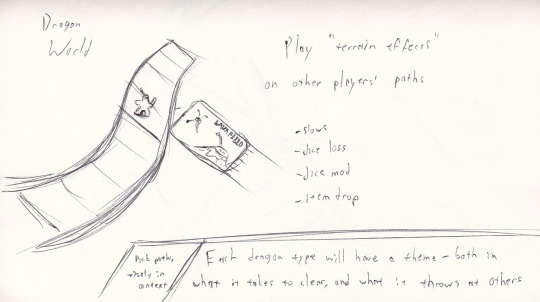
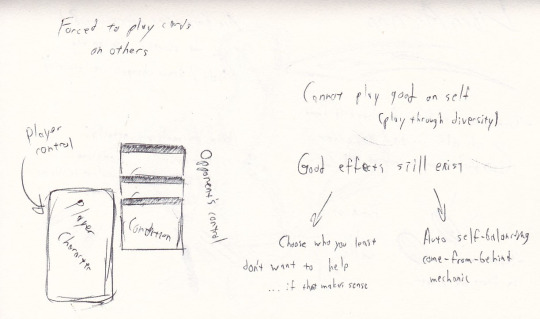
The game at this starting point was called "World of Dragons," and notably, had a number of tracks to fight along - one for each dragon in the game.
As early as the first few pages of notes however, the theme of inter-player tussling began to show its head. Partly arising as a way for players to interact despite the seperate tracks at this early stage, being able to play various effects on others sets the stage for all the meddling players are able to (and encouraged to) do in the current version of the game.
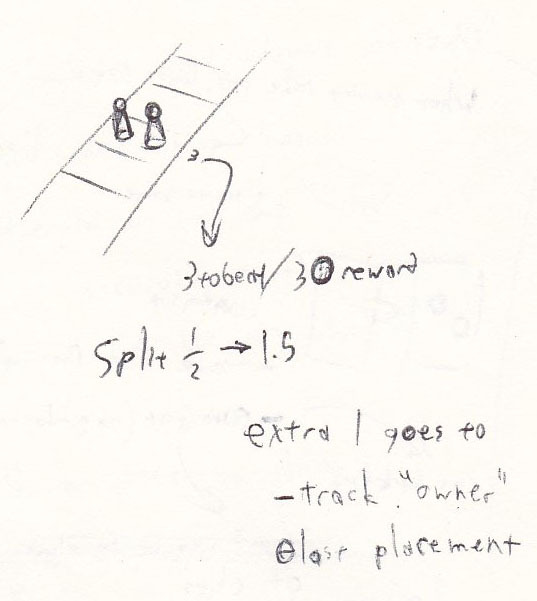
Another item that arrived early is the rule of "piggybacking." "Assisting" another player, (whether they want it or not,) in order to take part in their profits. An excellent source of inter-player meddling, this one rule has honestly been a thorn in my side ever since.
While regularly used by testers - sometimes to great effect - just writing this rule and its various edge cases in an intelligible manner has proved a continual pain.
On the other hand, once the emotional core of Cazadores was found - player-to-player meddling - the "piggybacking" action was found to exemplify this core a bit too well to just give up on... So the rewriting and re-rewriting continued.

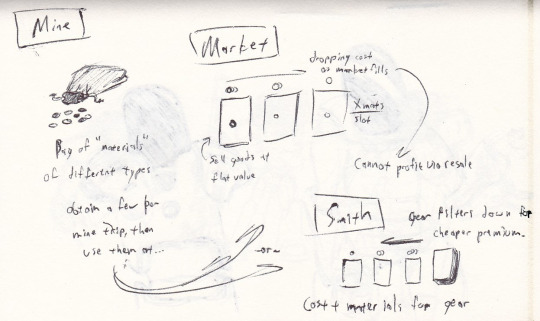
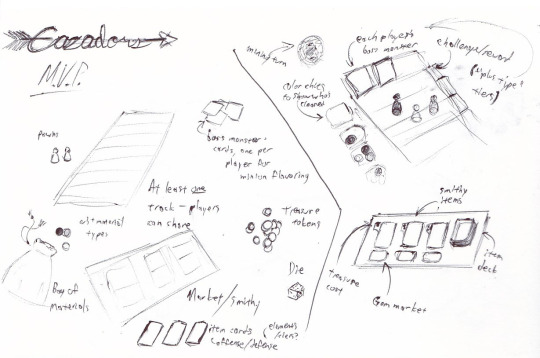
In due time, the seperate tracks merged into one, and the mine showed up, flanked by the market and smithy. The market itsself would fade away, replaced by the smithy as the current market.
By the time that I started working on the first MVP (Minimum Viable Product) version of the game for physical testing, Cazadores was beginning to recognizably look like Cazadores - complete with the new name!
(As a complete aside, the name Cazadores - or "The Hunters" in Spanish - came to mind as there was a local restaurant with the same name. And now this arbitrary name chjange is driving research into the mythology of the Spanish-speaking world as we head into the latter phases of the design!)
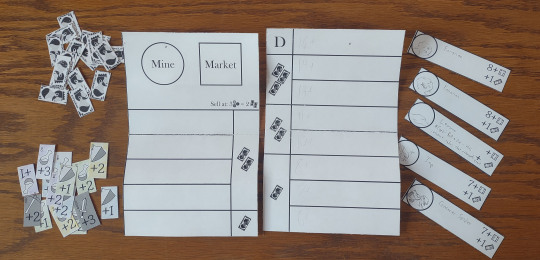
The MVP design is an absolute necessity in the design process - theory can only go so far before the game actually has to make the table. Once the board is on table and cards in hand you can actually see if the game WORKS.
It's suprising to me how massive faults can go completely unseen until actually playing the game through, step-by-step. In the past, more than one design has bit it at this step, simply becouase the implications of various actions were not considered, or taken to their logical conclusion. Thankfully, Cazadores pulled through, and design continued!
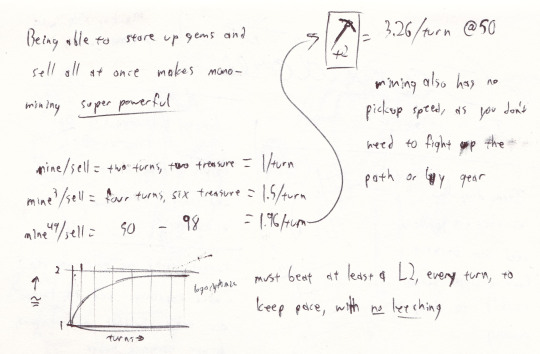
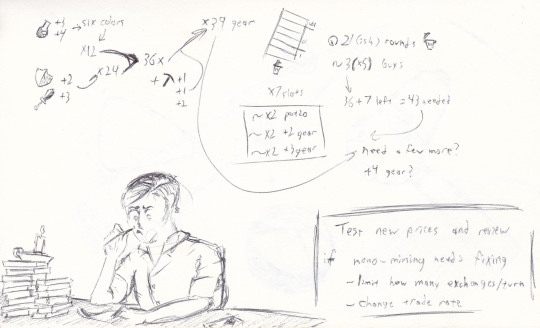
With the most basic of prototypes made, the amount of work - and notes - increases exponentially. And with it: the best part of game design - math.
Thankfully, while I may not have managed to achieve an engineering degree, game design generally doesn't need trigonometry to find holes in the design. Averages, earnings-per-turn, and action economy are fairly easy to figure out, but absolutely needed to be found at this basic lavel of testing, before anyone else so much as saw the game.
More than once, some strategies proved game-breakingly profitable, making the whole core of the game - hunting monsters - more of a secondary goal. But once the math was done and the game was balanced into a shaky, but stable position, it was time to test it with other people.




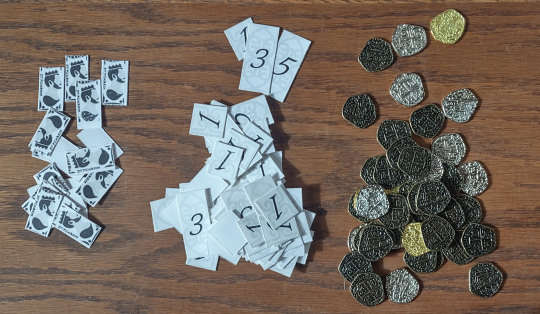
...and iterate. Print a new game, mark it up after one test, print a new one. Repeat ad infinitum. At this point, having a printer with a long-lasting toner cartridge rather than tempermental ink cartridges starts to pay off, because there is a LOT of printing.
Rules upon rules, boards upon boards, and so, so many item and monster cards. Black-and-white to start with, colored in by hand, and even the occaisional color print. Everything is temporary, and the priority is getting the fixes to the table - looks are a secondary concern.
And the game must make it to the table, as that's the only way to get the most valuable thing in the design process: player feedback. From family grinding out half a dozzen games on a snow day, to local groups trading soda for victory, to GenCon itsself, seeing people play this thing I made - it makes this long road worthwhile.
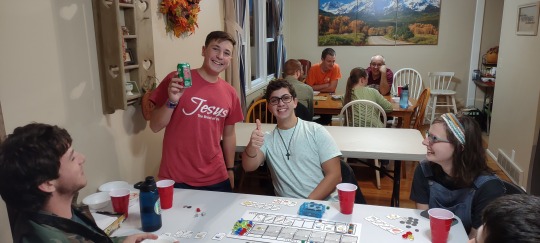
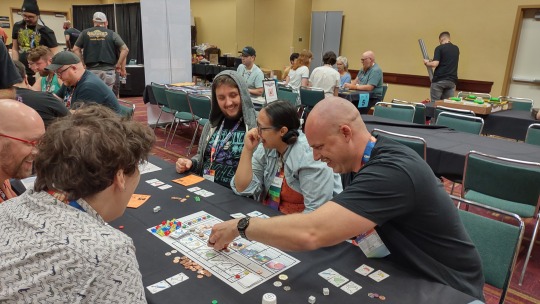
...and that's where we are now. The last rules are being balanced and added to the 1.5 edition of the rulebook, next year's convention season is being planned, and querries are being sent out to various production companies and others in order to plan the future. With any luck at all, next year I'll be writing a retrospective on a Kickstarter campaign!
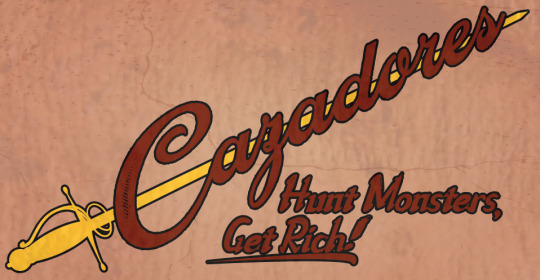
0 notes
Text



Cazadores is now on Tabletop Playground, Tabletop Simulator, AND Tabletopia!
Not publicly published yet, but they should be soon. Little bit of tweaking to finish them off, and some tweaking of the rules to bring them in-line with the (current) realities of the whitepaper prototype here. And playing them against some peope familiar with these tabletop simulators would be nice, too...
#TTS#tabletop simulator#tabletop playground#tabletopia#Cazadores#virtual#gamedesign#boardgames#Luft Games#simulator
0 notes
Text





Finally working on getting Cazadores to VTT state for testers. Only took two days and a handful of tutorials to get a vaguely-playable test setup. Do want to have multiple versions, over multiple tabletop simulators, so this is less than a third of the work I need to get done before release.
Biggest takeaway: know your measurements beforehand. Getting the pieces sized right is a lot quicker if you have them written down aforehand, and being able to math out things like the spacing of locations on a board really helps with plugging in snap points.
0 notes
Text




The entire story of Ill Winds* has been:
- add a lot of features
- review what is absolutely necessary
- remove a lot of features
- repeat
At least every cycle a feature or two finds a way to be streamlined into the minimum viable ruleset. Unfortunate that the cycle will continue indefinitely until I actually get it back to playtesting - a problem complicated by the fact that I myself am a horrible game master.
Oh, and as an aside, this will probably be the last game notes thing on this blog. Looking to move game stuff to another tumblr in hopes of going more in depth on things there and just leaving the crappy art archive going here. In theory.
*name in the process of changing so that it no longer sounds like a game about farts
#sketch#notes#Ill Winds#mygames#RPG#armor#shield#goblin#compass#sword#campaign#somanynotes#organization#demihuman#idk
0 notes
Text




Sure, I got swag from GenCon. Even bought a few things at exclusive con-sale prices. But the most important thing I got out of GenCon was twenty review slips and four pages of notes.
Few notes: one, absolutly give a review sheet. It's not replacement for actually talking to people in person, but it's also not replaced by talking in person. Some times you don't have time to get to everyone, and some people just don't speak up up as much, so having a planned set of prompts for people to work through is still valuable.
Make sure that review sheet is big, as well. My review sheet was only a half page, as I thought it would be less imposing, and therefore more likely to be filled out. Turns out, getting them filled out is not a problem. Paper is cheap, use it all. And I had knock-on consequences from this small format as well. Question two is "What was the best part of the game? The worst?" This, in case you hadn't noticed, is actually two questions. And they certainly could have used seperate lines. Having plenty of space for different types of handwriting is important as well.
Also, while I did get 80% of testers leaving an email for future contact, handwriting is not 100% guaranteed to be clear - I should have confirmed those before everyone left.
On the notes - be specific. Going in to a test environment with questions for yourself is helpful - i.e. "How do people feel about X? How often is Y mechanic used? Where is progress slow?" If there's some mechanic you know you want to test, record how often it's interacted with, and how people react to it. Record time logs, and what needs explaination, final scores and playstyles.
...Unfortunately, you can't get it all. Interacting with players is also important. Not to mention actually teaching the game - a con situation like this does have a time limit, and you can't afford to sit and watch from a corner like blind playtesting. Perhaps with a bigger team, there can be a dedicated scribe, a teacher, and so on. (But that depends on the resources available to you.)
One thing I want to stess to no end when it comes to interacting with players: Don't disagree with player feedback. You don't have to agree with it, you don't have to incorporate it, you may even be able to explain why you did something else, or if you tried that already, but don't say they're wrong.
I tested a game at GenCon several years ago, and made a comment on the game's balance. The response was: "No. You should have played better." That boardgame equivalent of "Git Good" rankles my spiteful memories to the point that I carry a grudge against it to this day. (Obviously, I won't actually name names... I'm not that spiteful.)
I may well have been a bad player due to a poor understanding of the rules, but the response should have been: "okay, we'll think abou it," and then go back to the other players who were gushing over the design. Acknowledge, and move on.
When taking feedback, you don't actually have to incorporate all of it, or even any of it. It's okay to ignore one opinion in the end. But look for trends. If one element get a single comment, you may want to look at it later. But if something consistently comes up as confusion or problematic, that should be your focus.
Oh, and while on the subject of interacting with players, ask if you can record and share the playtest. It's polite, and the least you can do. And you get good stock to remember interactions, and share on socials! (Oh, yeah, and have your socials set up beforehand, of course.)
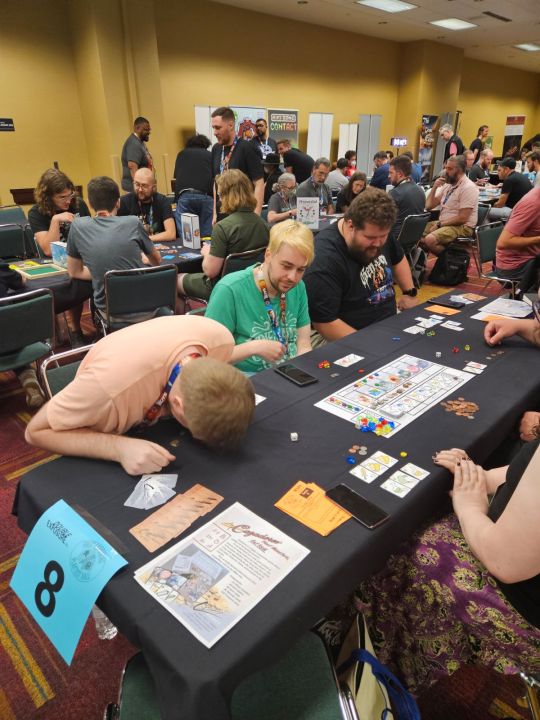

As for other things to consider when in a testing environment: handouts. It doesn't have to be a lot, but handing players something on the way out the door is key to making it memorable in a week's time, after the con is over.
As for what goes on this: Socials. Contacts are a must. Places to follow the game's progress, so that it can be looked up after the con. A description of the game as well - specifically the gameplay. It contextualizes the info, and can be a secondary hook for looking into those socials.
Also: Leave it around the venue. In the First Exposure Playtest Hall at GenCon there are several tables where you can leave literature - make use of that. Having the literature available, and not limited to handing out at-table, allows it to be a point of interest for people to look at pre-test, as well as something for people who didn't get an opportunity to test your game. Also, it's not exactly rare for publishers and other people to hoover these up at the end of a con - so having a stack left over is a way to passively get in contact with people and companies after the fact.

Cazadores' business card next to Fury of the Elements and Space-Off. The business card is easy to transport, and cheap to get in bulk. However, while having contact info and the game name, it does not have any form of game description. I would suggest a minimum of a post-card sized piece to get all the relevant info on it - a full-sheet is good for a complete breakdown, but also less convenient to pocket. One can also compromise by having multiple formats - that way all bases are covered. Also, say it with me: paper is cheap.
So yeah, that's what I took note of at my first convention appearance with Cazadores. ...GenCon, huh? Really chose to dive in on the deep end, eh? I do wish I'd taken more time slots - there's only so many people you can reach doing it like this. Other conventions have other rules for how testing works, and requirements for drawing a crowd, but I'd still say the same rules for taking notes and handouts apply.
Know what you want to find out going in.
Take everything - no suggestion is bad, and no notes are useless.
Look for trends.
Handouts are important.
Passive advertisement is not useless.
I think that's the key takeaways I want to leave you with. Anyways, I want to actually get into some of the history and mechanics of Cazadores (and other designs) at some point, when I have the time. Until then!

0 notes
Text





There's a lot of things to prep on the run up to showing off a game at GenCon - informational slides, reprints, prospective sale sheets, business cards so that people remember you... And the dice you decide to make two days before. Because everyone likes handouts, right? Probably should have started this process a little bit earlier, but if someone remembers Cazadores exists, it's still a win, right?
0 notes
Text

Some new color test prints. Probably need at least one duplicate of everything before heading to GenCon, but I'm currently dealing with new problems from new materials - turns out the printers available to me can't handle the new cardstock. Might need to invest in a new printer... Though I only need color prints a few times a year and ink is infamous for vanishing even without use... Ah, future problems!
...Near-future problems unfortunately...
0 notes
Text

Working today on a business card and a slide for the First Exposure Playtest Hall announcement board - would either make you stop to take a look?
While I quite enjoy dinking about in Photoshop - and especially Illustrator - I am still quite the amature.
...something especially evident when under a time crunch here, on the run-up to GenCon.
0 notes
Text

Current prototype for Cazadores. Due a reprint in a couple weeks, as we're going to GenCon with this! Double Exposure runs the very nice First Exposure Playtest Hall there, and (the newly rebranded) Luft Games will be there to show off our hyper-capitalist monster-hunting game. Come say hi, or at the very least, see who else is presenting new games at the hall!
0 notes